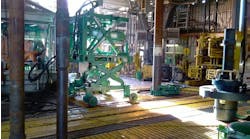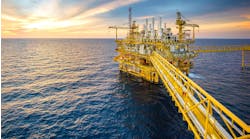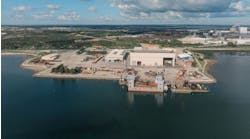Jeremy Beckman
London
Gas developments linked to Troll "swing" plan
Norway's Gas Supply Committee is inviting bids for the next round of fields to furnish gas sales contracts to continental Europe. Applications are due in by September - in cases involving new field developments, a PDO must also be submitted to the relevant authorities.New projects thought to be lined up include Saga's Halten Bank complex of fields off mid-Norway, and in the North Sea, Norsk Hydro's Drake, Elf's Skirne and Vale, and Statoil's Kvitebjørn. Gas from the latter could be piped either to Oseberg or to the Kollsnes refinery near Bergen for processing.
Bidders have also been offered the chance to use the Troll gasfield as a "swing supplier." The gas production platform's facilities would thereby be kept topped up with third party supplies while output from the Troll Field fluctuates, in line with daily customer demand. This plan, proposed by the Ministry of Petroleum and Energy, could necessitate expansion of the Troll gas treatment plant at Kollsnes at the rate of 80-110 MMcm/d.
The urgency over gas contrasts with Norwegian oilfield development, which the government has tried to suppress of late through slowing the project approval process. However, the Ministry has announced that a limited number of new production licences will be granted early next year, with priority given to acreage close to existing infrastructure or the UK and Danish median lines.
Mixed fortunes for Norwegian floaters
Production from Statoil's Veslefrikk Field could be extended by seven years to 2015 folowing an agreement to use the facilities to process condensate from the Huldra Field. But this extension relies partly on more reserves being found at Huldra and also Veslefrikk, where Statoil is currently seeking an HT/HP rig to drill the "C" prospect.Next summer, Veslefrikk production will be shut down for three months while the field's "B" floating platform is modified, with the aim of boosting daily processing capacity of 1.9-3.0 MMcf.
A storm in Singapore caused another floater, Saga's Varg newbuild, to break free from its moorings at the Keppel Fels yard. It then crashed into a rig, damaging its own hull. The FPSO, already a year behind schedule, was not expected to be ready as a result until late last month.
Construction delays to the newbuild semisubmsersible Bideford Dolphin, at the Harland and Wolff shipyard in Belfast, have also forced Saga to postpone drilling of its first ultra-deepwater well (1,900 meters) in the Gjallar Ridge by six months until next spring. Saga felt conditions this far north in the Norwegian Sea were too rough to risk winter drilling operations.
Mid-Norwegian production under study
Concrete substructures would be preferable to steel for Spar platforms in the Moere and Voering Basins. This is one of the conclusions from three recent studies led by Spars International, as it seeks to transfer its success with Spars in the Gulf of Mexico to northern Europe. Another recommendation was to move oil storage to the lower hull section. At clients' requests, the concepts were devised for use with polyester mooring systems, with a view to limiting the Spars' horizontal movements in these regions where water depths vary 900-1,500 meters.In the Haltenbanken, a project has been launched to combat buildup of viscous napthenate in process equipment on the Heidrun platform. Heidrun's crude contains high levels of napthenic acid, which solidifies when cooled in air. Build-up caused blockage of jet water outlets from the platform's separators in 1996. Statoil used hydrochloric acid to break down the deposits, but this is seen only as a temporary solution.
The problem, which also hit Kerr-McGee's Gryphon floater in the UK sector, may be linked to the water cut, according to Statoil newsletter Status Weekly. It reported that as the pH volume rises up the production tubing, calcium ions in the formation water bind to napthenic acids, creating calcium napthenate at the oil/water interface.
Burlington, BP spark life into UK sector
Burlington Resources likely will launch a new wave of gas developments in the Irish Sea, following a transportation agreement with British Gas division Centrica and its subsidiary Hydrocarbon Resources. Burlington acquired the Millom and Dalton gas discoveries and surrounding acreage last December. Previous owner BG Exploration and Production has deferred development, due to low UK gas trading prices.Assuming approval is forthcoming from the UK government, development of Dalton should start early next year, leading to first gas late in 1999. By then, work on Millom may also be under way with a view to achieving first production at year-end 2000. Hardware plans have not been issued, but the gas will head through Centrica's pipeline system in the Irish Sea to the treatment terminal in Barrow, north-west England which also serves the nearby Morecambe gas fields. Of late, these have also been rumored to be up for sale.
In the UK North Sea, BP is preparing a second phase of development at Harding via a series of oil and gas satellites tied back to the TPG 500 jackup production platform. Extended reach wells are planned to explore a gas prospect to the north of the platform and to appraise the 9/24 and J/24 gas discoveries to the southeast. Depending on the results, this gas could be piped to a new bridge-linked compressor platform.
Harding could also host oil processing from the Crawford Field in block 9/28a, which was decommissoned in 1991 following just 20 months in production. Previous operator BHP managed to extract 4 million bbl out of an estimated 200 million bbl in place - a recovery factor of 2%. Production was effected through the FPV North Sea Pioneer exporting via a single buoy mooring system and a shuttle tanker.
Operators on the move:
- Petrobras has strengthened its production position in the North Sea by acquiring Santos's UK upstream assets for around $80 million. The package includes 13.3% of a Marathon-operated block containing the Milburn discovery. Following appraisal drilling planned next year, this could be tied back to the Banff Field facilities, in which Santos also had a small stake.
- One of the Dutch sector stalwarts, Occidental Netherlands, has pulled out, preferring to concentrate on larger-scale operations in other regions. It has sold its interests in eight Dutch North Sea gas production licences, plus 38.6 % of the Noordgastransport pipeline management company, to TransCanada Pipelines for $275 million. Oxy's reserves in these licences are estimated at 191 bcf of gas.
Copyright 1998 Oil & Gas Journal. All Rights Reserved.


